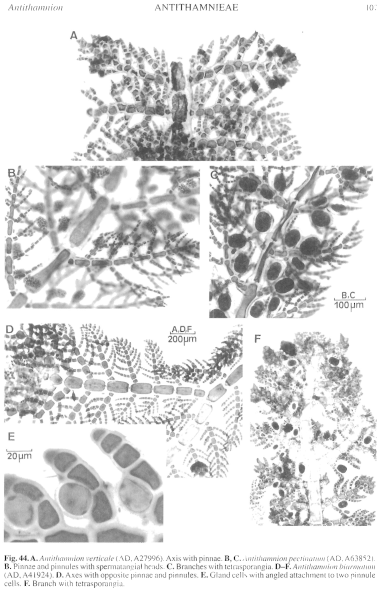|
|
|
|
|
|||||||||||
|
Electronic Flora of South Australia Species Fact Sheet
Phylum Rhodophyta – Order Ceramiales – Family Ceramiaceae – Tribe Antithamnieae
Selected citations: Athanasiadis 1996: 146, fig. 67.
Synonyms
Callithamnion pectinatum Montagne 1842: 9.
Callithamnion applicitum Harvey 1855c: 258.
Antithamnion applicitum (Harvey) J. Agardh 1892: 21.
Thallus (Fig. 44B) with prostrate axes bearing erect axes 3–25 mm long, complanately branched with opposite, distichous, whorl-branchlets (pinnae) from each axial cell. Attachment by multicellular rhizoids with digitate haptera, arising from basal cells of pinnae; epiphytic. Structure. Apical cells 6–10 µm in diameter and L/D 1.5–2, enlarging to 50–90 µm in diameter and L/D (2–) 3–4 in mature axial cells. Pinnae closely branched, 300–550 µm and 10–12 cells long, rachis cells (apart from the basal) with opposite, distichous pinnules 90–270 µm and 8–12 cells long, simple or the larger ones with a branch; rachis cells 25–40 µm in diameter and L/D 2–4, the basal cell isodiametric, tapering to subterminal cells 8–12 µm in diameter and L/D 1–1.5, terminal cells with rounded ends; pinnule cells 10–14 µm in diameter and L/D 1–1.5; gland cells on pinnules or their short branches, occasional, in contact with one or both adjacent cells, ovoid, 15–20 µm in diameter. Lateral branches arising on the basal cells of pinnae. Cells uninucleate; rhodoplasts discoid in small cells, ribbon like in larger cells.
Reproduction: Gametophytes dioecious. Carpogonial branches borne on the basal cells of pinnae, one to several near apices; post-fertilization producing 1–3 gonimolobes 250–450 µm across, with ovoid carposporangia 25–55 µm across, surrounded by adjacent pinnae. Spermatangial heads (Fig. 44B) ovoid, sessile, on the basal (or next) cells of pinnules, 30–45 in diameter, with an axial row of 4–6 cells producing whorls of initials and outer spermatangia.
Tetrasporangia (Fig. 44C) borne on the basal cells of pinnules, sessile, ovoid, 50–75 in diameter, decussately divided.
Type from "Auckland" [almost certainly Auckland I., since the city of Auckland in New Zealand was not established until 1840 and the D'Urville (1940) expedition did not visit the site of Auckland]; holotype in Herb. Montagne, PC.
Selected specimens: Portland, Vic., 8–11 m deep N of Lawrence Rock (Owen, 2.ix.1971 ; AD, A39705). Gabo I., Vic., on Carpoglossum, 28 m deep (Shepherd, 19.ii.1973; AD, A43549). Pirates Bay, Eaglehawk Neck, Tas., on Polyopes, 9–12 m deep (Gowlett-Holmes, 31.x.1994; AD, A64054). N end Governor I., Bicheno, Tas., on Rhodymenia, 8–16 m deep (Edgar, 23.x.1994; AD, A63852). Taroona, Tas., on Polyopes, 2–3 m deep (Shepherd, 19.iii.1975; AD, A46153). Quiet Corner, Adventure Bay, Bruny I., Tas., epiphytic, 10 m deep (Shepherd, 16.ii.1972; AD, A41585).
Distribution: New Zealand; probably widespread (see Athanasiadis 1996, p. 147).
In southern Australia, from Portland and Gabo I., Vic., and SE Tasmania.
References:
AGARDH, J.G. (1892). Analecta Algologica. Acta Univ. lund. 28, 1–182, Plates 1–3.
ATHANASIADIS, A. & TITTLEY, I. (1994). Antithamnioid algae (Rhodophyta, Ceramiaceae) newly recorded from the Azores. Phycologia 33(2), 77–80.
ATHANASIADIS, A. (1996). Morphology and classification of the Ceramioideae (Rhodophyta) based on phylogenetic principles. Opera Botanica No. 128, pp. 1–216.
HARVEY, W.H. (1855c). Algae. In Hooker, J.D., The Botany of the Antarctic Voyage. II. Flora Novae-Zelandiae. Part II, pp. 211–266, Plates 107–121. (Reeve: London.)
MONTAGNE, C. (1842) Troisieme centurie de plantes cellulaires exotiques nouvelles. Decades V, VI, VII, et VIII. Ann. Sci. Nat. Bot. Ser. 2, 18, 241–282, Plate 7.
The Marine Benthic Flora of Southern Australia Part IIIC complete list of references.
Publication:
Womersley, H.B.S. (24 December, 1998)
The Marine Benthic Flora of Southern Australia
Rhodophyta. Part IIIC. Ceramiales – Ceramiaceae, Dasyaceae
©State Herbarium of South Australia, Government of South Australia
Illustration in Womersley Part IIIA, 1998: FIGS 44B, C.

Figure 44 enlarge
Fig. 44. A. Antithamnion verticals (AD, A27996). Axis with pinnae. B, C. Antithamnion pectinatum (AD, A63852). B. Pinnae and pinnules with spermatangial heads. C. Branches with tetrasporangia. D–F. Antithamnion biarmatum (AD, A41924). D. Axes with opposite pinnae and pinnules. E. Gland cells with angled attachment to two pinnule cells. F. Branch with tetrasporangia.

|
Email Contact: State Herbarium of South Australia |

|